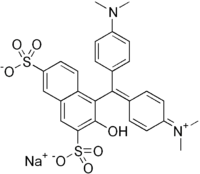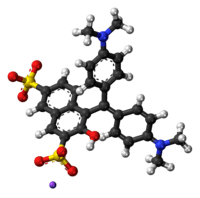Green S
 | |
 | |
| Names | |
|---|---|
| IUPAC name
Sodium 4-[(4-dimethylaminophenyl)-(4-dimethylazaniumylidene-1-cyclohexa-2,5-dienylidene)methyl]-3-hydroxynaphthalene-2,7-disulfonate | |
| Other names
Food Green S; FD&C Green 4; Acid green 50; Lissamine Green B; Wool Green S; C.I. 44090; E142 | |
| Identifiers | |
| 3087-16-9 | |
| ChemSpider | 82646 |
| Jmol interactive 3D | Image |
| PubChem | 91525 |
| UNII | 9B7E8Y9D0X |
| |
| |
| Properties | |
| C27H25N2NaO7S2 | |
| Molar mass | 576.62 g/mol |
| Melting point | 210 °C (410 °F; 483 K) (decomposes)[1] |
| Hazards | |
| R-phrases | R22 |
| Except where otherwise noted, data are given for materials in their standard state (at 25 °C [77 °F], 100 kPa). | |
| | |
| Infobox references | |
Green S is a green synthetic coal tar triarylmethane dye with the molecular formula C27H25N2O7S2Na.
As a food dye, it has E number E142. It can be used in mint sauce, desserts, gravy granules, sweets, ice creams, and tinned peas. Green S is prohibited as a food additive in Canada, United States, Japan, and Norway. It is approved for use as a food additive in the EU[2] and Australia and New Zealand.[3]
Green S is a vital dye, meaning it can be used to stain living cells. It is used in ophthalmology, among fluorescein and rose bengal, to diagnose various disorders of the eye's surface.
Green S may cause allergic reactions and is one of the colorants that the Hyperactive Children's Support Group recommends to be eliminated from the diet of children.
References
- ↑ http://www.sigmaaldrich.com/MSDS/MSDS/DisplayMSDSPage.do?country=TW&language=en&productNumber=B6756&brand=SIGMA&PageToGoToURL=http%3A%2F%2Fwww.sigmaaldrich.com%2Fcatalog%2Fsearch%3Finterface%3DAll%26term%3DGreen%2BS%26N%3D0%26mode%3Dmatch%2520partialmax%26focus%3Dproduct%26lang%3Den%26region%3DTW
- ↑ UK Food Standards Agency: "Current EU approved additives and their E Numbers". Retrieved 2011-10-27.
- ↑ Australia New Zealand Food Standards Code"Standard 1.2.4 - Labelling of ingredients". Retrieved 2011-10-27.
Eighteenth Report of the Joint FAO/WHO Expert Committee on Food Additives (JECFA), Wld Hlth Org. techn. Rep. Ser., 1974, No. 557. FAO Nutrition Meetings Report Series, 1974, No. 54. Presented in